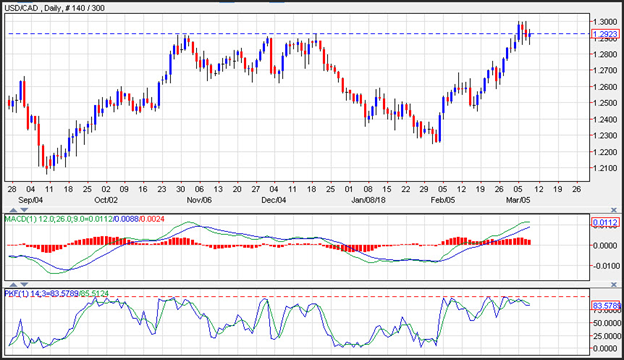The Canadian Dollar has been trading under pressure as tariffs could weigh on the currency. The Bank of Canada delivered the widely expected lack of change, leaving the setting for the overnight rate at 1.25%. While higher rates over time remain implied by their economic outlook, they repeated that they will be cautious in considering future policy adjustments. Their views on recent developments were largely balanced, but with a notable mention of the growing uncertainty to Canada’s outlook posed by trade policy. The markets projection is for two more rate increases this year, in July and October, leaving a 1.75% setting by year-end.
The crucial final paragraph of the announcement was little changed relative to January. The repeat of “further rate hikes likely but guided by data and implemented with caution” is a place-holder as they observe the evolution of trade policy, wages, housing and GDP.
The Bank of Canada expects GDP growth of 3% in 2017 in-line with the Bank’s projection in the January monetary policy report. Yet that was largely due to higher imports, which mainly reflected stronger business investment. The key for policy going forward is the evolution of GDP and inflation relative to their projections. But uncertainty remains elevated, including the tariff plans from the White House in the United States making for a policy outlook that is written in very light pencil.
The March announcement revealed little change in the cautious, data dependent Bank of Canada. Hence, they should be able to hold policy steady until past mid-year, providing ample time to access the impact of NAFTA and possible U.S. tariffs on trade and investment. The long-anticipated rotation to export and business investment from household spending and housing is moving along in fits and starts. Of course, household spending did slow in Q4, which is something the Bank has been eying for some time. The announcement assured that they are continuing to monitor the economy’s sensitivity to higher interest rates, noting that household credit growth has decelerated for three consecutive months.
Three Rate Hikes in 2018
The Bank of Canada is expected to move again in July, lifting rates 25 basis point to 1.50%. Another 25-basis point rate hike is penciled in for October to leave a 1.75% rate that should close out the year. But the risk is intensifying that the economy faces fresh headwinds from trade and housing this year. Of course, an expanding U.S. economy would provide a strong tailwind for Canada, if trade protectionism does not weaken the link between the two nations. In other words, uncertainty clouds the outlook, leaving a gradual and cautious course ahead as the most sensible policy path for the Bank of Canada this year.
Canada housing starts improved
Canada housing starts improved to a 229.7k unit pace in February from a revised 215.3k growth rate in January. Currency trading of the Canadian Dollar saw the Loonie remain stable. The pick-up in starts was contrary to expectations for a mild dip and comes amid general softness in sales and prices so far this year as new mortgage rules and other measures pulled-activity ahead to late 2017. Starts saw a 6-month average of 225.3k in February versus 224.6k in January, maintain a steady growth rate since November of last year. Single detached starts fell 9.8% to a 56.7k rate in February while multiple urban starts jumped 15% to 154.5k in February. By region, starts improved in Toronto and Vancouver, with a record number of apartment starts featuring in Toronto.
